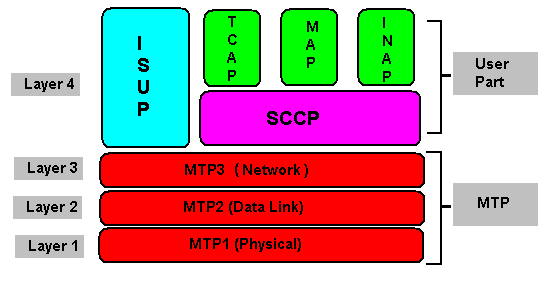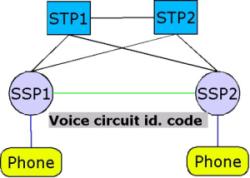分类: 系统运维
2008-12-06 01:44:16
Common Channel Signaling System #7 (SS7) separates the information required to set up and manage telephone calls in the Public Switched Telephone Network (PSTN) onto a separate packet switched network (The Signaling Network) rather than use the same circuit switched network that the telephone call is made on (The Voice Network). This technique is commonly called out-of-band signaling and constrasts with earlier in-band techniques (Channel Associated Signaling - CAS) which used MF tones. The SS7 network consists of .

Figure 1.0
Signaling Points
SSP = Service Switching Point
STP = Signal Transfer Point: Usually deployed in pairs in case of failure
SCP = Service Control Point: Usually deployed in pairs in case of failures.
All nodes in the SS7 network are called Signaling Points (SPs). Each SP is identified by a unique address called a Point Code (PC). SPs have the ability to read a Point Code and determine if the message is for that node and the ability to route SS7 messages to another SP. The three types of Signaling Points are:
SSPs are switches, for example, Class 5 (local) and Class 4 (tandem) with SS7 interfaces.
SSPs convert global title digits (i.e. a dialed number) from a subscriber line to SS7 signaling messages.
SSPs setup, manage and release voice circuits required to make a call.
To summarize, an SSP's function is to use a global title to determine how to connect a call using its routing table.
There are 3 call setup scenarios an SSP will encounter:
A call originates at an SSP and is destined for a known SSP: In this case the originating SSP looks at its routing table to determine how to route the call then sends a message to the destination SSP using the protocol. This typically will only happen with .
The global title (called part number) may be an 800 or a ported number. In this case the originating SSP performs a TCAP transaction with via an STP to determine the point code of the destination SCP. The SCP will return a new Global Title. The originating SSP uses this number to route the call.
The SSP routing table yields the address of an SSP (a next hop SSP) and the Call set-up sequence message (the IAM) is sent, via an STP, to this SSP which in turn will route the message to the next hop and so on untilthe mesaage reaches the destination SSP.
An STP is a router and/or a gateway in the SS7 network.
Messages are not originated by an STP.
STPs switch SS7 messages between Signaling Points.
If an originating SSP does not know the address of a destination SSP, the STP must provide it using
Gateway STPs serve as the interface into another network and they can provide protocol conversion .
STPs also provide traffic and usage measurements.
An SCP provides application access. It is an interface to applications such as databases.
An SCP communicates with applications using primitives. A primitive is an interface that provides access from one level of a protocol to another level.
The protocol used to access and interface a database application is .
All SPs (signalling points) are connected using (typically) pairs of Links. Each Link type is identificed with a letter as defined below:
All links use the same physical connections (typically DS0A - 56K bit/s or DS1 (T1)). The letter designation allows differing congestion and recovery treatment.
The standard SS7 protocol has 4 levels (layers) as defined in the OSI 7 Layer Model. The levels 1 to 3 constitute the Message Transfer Part (MTP) and level 4 is the User Part (Transport Layer in OSI).

The SS7 Protocol Stack Model
MTP1 = Message Transfer Part 1
MTP2 = Message Transfer Part 2
MTP3 = Message Transfer Part 3
SCCP = Signaling Connection Control Part
TCAP = Transaction Capabilities Application Part
MAP = Mobile Application Part
INAP = Intelligent Network Application Part
ISUP = ISDN User Part
NOTE: TCAP, MAP and INAP are examples of services that use SCCP ().
SS7 uses three types of packets, called Signal Units (SUs) only one of which carries data. The Fill-in Signal Unit (FISU) is sent when the link is idle and allows the end-points to monitor signal quality and link integrity. The Link Status Signal Unit (LSSU) is sent when a link error occurs. Message Signal Units (MSU) carry protocol payloads such as ISUP, MAP etc.
The MTP acts as the carrier for all SS7 messages providing reliable transfer from one SP to another (node-to-node) with error detection and correction. MTP covers levels 1-3 in the OSI stack. [MTP ITU-T Specs: Q.701-Q.705 ANSI: T1.111.1 - T1.111.8]
MTP1 (physical layer): ITU-T Specs: Q.702
MTP1 is equivalent to the physical layer of the OSI model
MTP1 defines the physical and electrical characteristics of the signaling link.
The physical interfaces defined for SS7 include E-1 (2048kb/s; 3264kb/s channels), DS-1(1544kb/s; 24 64kb/s channels), V.35(64kb/s), DS-0(64kb/s) and DS-0A(56kb/s).
MTP2 (Data link layer): [ ITU-T Specs. Q.703 ]
Implements flow control, message sequence validation, error checking and error recovery.
MTP3 (Network layer): [ ITU-T Specs. Q.704 ]
MTP3 routes messages based on the Signaling Information Field(SIF) of an MSU. The routing label consists of the Destination Point Code(DPC), Originating Point Code (OPC) and Signaling Link Selection (SLC) field. When an MSU arrives at an SP and the DPC matches the point code of that SP, the message is sent to the appropriate user part (SCCP or ISUP).
ITU-T Specs: Q.760 - Q.769 ANSI: T1.113.1 - T1.113.4
ISUP defines one call control protocol used to set-up, manage and release circuits that carry voice and data calls in the PSTN. ISUP uses the MTP for routing messages from one SSP to another.
Notes

Example: ISUP signaling associated with a basic call
ISUP Messages
IAM = Initial Address Message
ACM = Address Complete Message
ANM = ANswer Message
REL = RElease Message
RLC = Release Complete Message
ITU-T Specs: Q.711 - Q.719 ANSI: T1.112.1 - T1.112.5
SCCP provides connectionless and connection-oriented network services via MTP3 for the transfer of signaling messages between SSP's. While MTP3 provides point codes to allow messages to be addressed to specific signaling points, SCCP provides Subsystem Numbers (SSN) to let messages be addressed to specific applications at these signaling points. MTP transfers messages node-to-node while SCCP transfers messages end-to-end.
SCCP is used as the transport layer for TCAP based services like, freephone(800/888), local number portability and roaming. SCCP also provides the means by which an STP can provide Global Title translation. Because an STP provides global title translation, originating SSPs do no need to know the or of the associated service. only STPs need to maintain the tables of destination point codes or SSNs associated with specific services and possible destinations.
ITU-T Specs: Q.770 - Q.779 ANSI: T1.114.1 - T1.114.5
TCAP messages are destined for application entities.
TCAP is designed for non-circuit related messages.
TCAP provides a means for SCP-to-SCP communication via STP's.
TCAP messages are used by SSPs to query an SCP (via an STP) to determine the routing numbers associated with a global title. The SCP uses TCAP to return a response containing the routing numbers back to the SSP via STP.
TCAP messages are transfered end-to-end using the services of SCCP.
TCAP is not limited to database access, it is also used to invoke other features from remote switches. TCAP services include freephone, calling card, and wireless roaming.

In SS7, a dialed number is referred to as a global title. If the SSP does not know the destination of a global title, it sends a query in the form of TCAP messages to its local STP. When the query gets to the STP, the global title digits are given to the STP's SCCP. The STP will then translate the SCCP address fields and determine, through its own translation tables the address of the application (SCP). The Global Title Translation provides the SSN of the database and point code of the SCP that interfaces that database application.